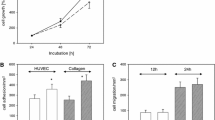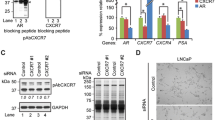Abstract
The receptor (CXCR4) for the stromal-derived factor-1 (SDF1) and the urokinase-receptor (uPAR) are up-regulated in various tumors. We show that CXCR4-transfected cells migrate toward SDF1 on collagen (CG) and do not on vitronectin (VN). Co-expression of cell-surface uPAR, which is a VN receptor, impairs SDF1-induced migration on CG and allows migration on VN. Blocking fMLP receptors (fMLP-R), alpha-v integrins or the uPAR region capable to interact with fMLP-Rs, impairs migration of uPAR/CXCR4-transfected cells on VN and restores their migration on CG. uPAR co-expression also reduces the adherence of CXCR4-expressing cells to various components of the extracellular matrix (ECM) and influences the partitioning of beta1 and alpha-v integrins to membrane lipid-rafts, affecting ECM-dependent signaling. uPAR interference in CXCR4 activity has been confirmed in cells from prostate carcinoma. Our results demonstrate that uPAR expression regulates the adhesive and migratory ability of CXCR4-expressing cells through a mechanism involving fMLP receptors and alpha-v integrins.










Similar content being viewed by others
References
Murdoch C (2000) CXCR4: chemokine receptor extraordinaire. Immunol Rev 177:175–184
Balkwill F (2004) The significance of cancer cell expression of the chemokine receptor CXCR4. Semin Cancer Biol 14:171–179
Kucia M, Reca R, Miekus K, Wanzeck J, Wojakowski W, Janowska-Wieczorek A, Ratajczak J, Ratajczak MZ (2005) Trafficking of normal stem cells and metastasis of cancer stem cells involve similar mechanisms: pivotal role of the SDF-1-CXCR4 axis. Stem Cells 23:879–894
Zlotnik A (2006) Chemokines and cancer. Int J Cancer 119:2026–2029
Burger JA, Kipps TJ (2006) CXCR4: a key receptor in the crosstalk between tumor cells and their microenvironment. Blood 107:1761–1767
Irigoyen JP, Munoz-Canoves P, Montero L, Koziczak M, Nagamine Y (1999) The plasminogen activator system: biology and regulation. Cell Mol Life Sci 56:104–132
Cunningham O, Andolfo A, Santovito ML, Iuzzolino L, Blasi F, Sidenius N (2003) Dimerization controls the lipid raft partitioning of uPAR/CD87 and regulates its biological functions. EMBO J 22:5994–6003
Viola A, Gupta N (2007) Tether and trap: regulation of membrane-raft dynamics by actin-binding proteins. Nat Rev Immunol 7:889–896
Ragno P (2006) The urokinase receptor: a ligand or a receptor? Story of a sociable molecule. Cell Mol Life Sci 63:1028–1037
Felding-Habermann B, Cheresh DA (1993) Vitronectin and its receptors. Curr Opin Cell Biol 5:864–868
Henry C, Moitessier N, Chapleur Y (2002) Vitronectin receptor alpha(V)beta(3) integrin antagonists: chemical and structural requirements for activity and selectivity. Mini Rev Med Chem 2:531–534
Montuori N, Ragno P (2009) Multiple activities of a multifaceted receptor: roles of cleaved and soluble uPAR. Front Biosci 14:2494–2503
Resnati M, Pallavicini I, Wang JM, Oppenheim J, Serhan CN, Romano M, Blasi F (2002) The fibrinolytic receptor for urokinase activates the G protein-coupled chemotactic receptor FPRL1/LXA4R. Proc Natl Acad Sci USA 99:1359–1364
Montuori N, Carriero MV, Salzano S, Rossi G, Ragno P (2002) The cleavage of the urokinase receptor regulates its multiple functions. J Biol Chem 277:46932–46939
Le Y, Murphy PM, Wang JM (2002) Formyl-peptide receptors revisited. Trends Immunol 23:541–548
Fazioli F, Resnati M, Sidenius N, Higashimoto Y, Appella E, Blasi F (1997) A urokinase-sensitive region of the human urokinase receptor is responsible for its chemotactic activity. EMBO J 16:7279–7286
Selleri C, Montuori N, Ricci P, Visconte V, Carriero MV, Sidenius N, Serio B, Blasi F, Rotoli B, Rossi G, Ragno P (2005) Involvement of the urokinase-type plasminogen activator receptor in hematopoietic stem cell mobilization. Blood 105:2198–2205
Gargiulo L, Longanesi-Cattani I, Bifulco K, Franco P, Raiola R, Campiglia P, Grieco P, Peluso G, Stoppelli MP, Carriero MV (2005) Cross-talk between fMLP and vitronectin receptors triggered by urokinase receptor-derived SRSRY peptide. J Biol Chem 280:25225–25232
Furlan F, Orlando S, Laudanna C, Resnati M, Basso V, Blasi F, Mondino A (2004) The soluble D2D3(88–274) fragment of the urokinase receptor inhibits monocyte chemotaxis and integrin-dependent cell adhesion. J Cell Sci 117:2909–2916
Li BQ, Wetzel MA, Mikovits JA, Henderson EE, Rogers TJ, Gong W, Le Y, Ruscetti FW, Wang JM (2001) The synthetic peptide WKYMVm attenuates the function of the chemokine receptors CCR5 and CXCR4 through activation of formyl peptide receptor-like 1. Blood 97:2941–2947
Le Y, Shen W, Li B, Gong W, Dunlop NM, Wang JM (1999) A new insight into the role of “old” chemotactic peptide receptors FPR and FPRL1: down-regulation of chemokine receptors CCR5 and CXCR4. Forum (Genova) 9:299–314
Svensson L, Redvall E, Johnsson M, Stenfeldt AL, Dahlgren C, Wennerås C (2009) Interplay between signaling via the formyl peptide receptor (FPR) and chemokine receptor 3 (CCR3) in human eosinophils. J Leukoc Biol 86:327–336
Chigaev A, Waller A, Amit O, Halip L, Bologa CG, Sklar LA (2009) Real-time analysis of conformation-sensitive antibody binding provides new insights into integrin conformational regulation. J Biol Chem 284:14337–14346
Huang J, Chen K, Gong W, Dunlop NM, Wang JM (2008) G-protein coupled chemoattractant receptors and cancer. Front Biosci 13:3352–3363
Selleri C, Montuori N, Ricci P, Visconte V, Baiano A, Carriero MV, Rotoli B, Rossi G, Ragno P (2006) In vivo activity of the cleaved form of soluble urokinase receptor: a new hematopoietic stem/progenitor cell mobilizer. Cancer Res 66:10885–10890
Madsen CD, Ferraris GM, Andolfo A, Cunningham O, Sidenius N (2007) uPAR-induced cell adhesion and migration: vitronectin provides the key. J Cell Biol 177:927–939
Wolfenson H, Henis YI, Geiger B, Bershadsky AD (2009) The heel and toe of the cell’s foot: a multifaceted approach for understanding the structure and dynamics of focal adhesions. Cell Motil Cytoskelet 66:1017–1029
Wei Y, Waltz DA, Rao N, Drummond RJ, Rosenberg S, Chapman HA (1994) Identification of the urokinase receptor as an adhesion receptor for vitronectin. J Biol Chem 269:32380–32388
Yuan C, Huang M (2007) Does the urokinase receptor exist in a latent form? Cell Mol Life Sci 64:1033–1037
Gårdsvoll H, Ploug M (2007) Mapping of the vitronectin-binding site on the urokinase receptor: involvement of a coherent receptor interface consisting of residues from both domain I and the flanking interdomain linker region. J Biol Chem 282:13561–13572
Ali H, Richardson RM, Haribabu B, Snyderman R (1999) Chemoattractant receptor cross-desensitization. J Biol Chem 274:6027–6030
Rabiet MJ, Huet E, Boulay F (2007) The N-formyl peptide receptors and the anaphylatoxin C5a receptors: an overview. Biochimie 89:1089–1106
Bifulco K, Longanesi-Cattani I, Gargiulo L, Maglio O, Cataldi M, De Rosa M, Stoppelli MP, Pavone V, Carriero MV (2008) An urokinase receptor antagonist that inhibits cell migration by blocking the formyl peptide receptor. FEBS Lett 582:1141–1146
Blasi F, Carmeliet P (2002) uPAR: a versatile signalling orchestrator. Nat Rev Mol Cell Biol 3:932–943
Ossowski L, Aguirre-Ghiso JA (2000) Urokinase receptor and integrin partnership: coordination of signaling for cell adhesion, migration and growth. Curr Opin Cell Biol 12:613–620
Franco P, Vocca I, Carriero MV, Alfano D, Cito L, Longanesi-Cattani I, Grieco P, Ossowski L, Stoppelli MP (2006) Activation of urokinase receptor by a novel interaction between the connecting peptide region of urokinase and alpha v beta 5 integrin. J Cell Sci 119:3424–3434
Carriero MV, Del Vecchio S, Capozzoli M, Franco P, Fontana L, Zannetti A, Botti G, D’Aiuto G, Salvatore M, Stoppelli MP (1999) Urokinase receptor interacts with alpha(v)beta5 vitronectin receptor, promoting urokinase-dependent cell migration in breast cancer. Cancer Res 59:5307–5314
Wei Y, Lukashev M, Simon DI, Bodary SC, Rosenberg S, Doyle MV, Chapman HA (1996) Regulation of integrin function by the urokinase receptor. Science 273:1551–1555
Del Pozo MA (2004) Integrin signaling and lipid rafts. Cell Cycle 3:725–728
Lajoie P, Goetz JG, Dennis JW, Nabi IR (2009) Lattices, rafts, and scaffolds: domain regulation of receptor signaling at the plasma membrane. J Cell Biol 185:381–385
Nguyen DH, Taub D (2002) CXCR4 function requires membrane cholesterol: implications for HIV infection. J Immunol 168:4121–4126
Harburger DS, Calderwood DA (2009) Integrin signalling at a glance. J Cell Sci 122:159–163
Festuccia C, Dolo V, Guerra F, Violini S, Muzi P, Pavan A, Bologna M (1998) Plasminogen activator system modulates invasive capacity and proliferation in prostatic tumor cells. Clin Exp Metastasis 16:513–528
Cannio R, Rennie PS, Blasi F (1991) A cell-type specific and enhancer-dependent silencer in the regulation of the expression of the human urokinase plasminogen activator gene. Nucleic Acids Res 19:2303–2308
de Paulis A, Montuori N, Prevete N, Fiorentino I, Rossi FW, Visconte V, Rossi G, Marone G, Ragno P (2004) Urokinase induces basophil chemotaxis through a urokinase receptor epitope that is an endogenous ligand for formyl peptide receptor-like 1 and -like 2. J Immunol 173:5739–5748
Aguirre Ghiso JA, Kovalski K, Ossowski L (1999) Tumor dormancy induced by downregulation of urokinase receptor in human carcinoma involves integrin and MAPK signaling. J Cell Biol 147:89–104
Luo BH, Carman CV, Springer TA (2007) Structural basis of integrin regulation and signaling. Annu Rev Immunol 25:619–647
Degryse B, Resnati M, Czekay RP, Loskutoff DJ, Blasi F (2005) Domain 2 of the urokinase receptor contains an integrin-interacting epitope with intrinsic signaling activity: generation of a new integrin inhibitor. J Biol Chem 280:24792–24803
Chaurasia P, Aguirre-Ghiso JA, Liang OD, Gardsvoll H, Ploug M, Ossowski L (2006) A region in urokinase plasminogen receptor domain III controlling a functional association with alpha5beta1 integrin and tumor growth. J Biol Chem 281:14852–14863
Kucia M, Jankowski K, Reca R, Wysoczynski M, Bandura L, Allendorf DJ, Zhang J, Ratajczak J, Ratajczak MZ (2004) CXCR4-SDF-1 signalling, locomotion, chemotaxis and adhesion. J Mol Histol 35:233–245
Epstein RJ (2004) The CXCL12-CXCR4 chemotactic pathway as a target of adjuvant breast cancer therapies. Nat Rev Cancer 4:901–909
Waugh DJ, Wilson C, Seaton A, Maxwell PJ (2008) Multi-faceted roles for CXC-chemokines in prostate cancer progression. Front Biosci 13:4595–4604
Wong D, Korz W (2008) Translating an antagonist of chemokine receptor CXCR4: from bench to bedside. Clin Cancer Res 14:7975–7980
de Bock CE, Wang Y (2004) Clinical significance of urokinase-type plasminogen activator receptor (uPAR) expression in cancer. Med Res Rev 24:13–39
Sidenius N, Blasi F (2003) The urokinase plasminogen activator system in cancer: recent advances and implication for prognosis and therapy. Cancer Metastasis Rev 22:205–222
Pillay V, Dass CR, Choong PF (2007) The urokinase plasminogen activator receptor as a gene therapy target for cancer. Trends Biotechnol 25:33–39
Acknowledgments
This work was supported by grants from the Ministero dell’Istruzione, dell’Università e della Ricerca (MIUR, PRIN 2007), from Associazione Italiana per la Ricerca sul Cancro (AIRC, IG 4714) and from Ministero Italiano della Salute-FSN2007.
Author information
Authors and Affiliations
Corresponding author
Additional information
N. Montuori and K. Bifulco contributed equally to this work.
Rights and permissions
About this article
Cite this article
Montuori, N., Bifulco, K., Carriero, M.V. et al. The cross-talk between the urokinase receptor and fMLP receptors regulates the activity of the CXCR4 chemokine receptor. Cell. Mol. Life Sci. 68, 2453–2467 (2011). https://doi.org/10.1007/s00018-010-0564-7
Received:
Revised:
Accepted:
Published:
Issue Date:
DOI: https://doi.org/10.1007/s00018-010-0564-7




